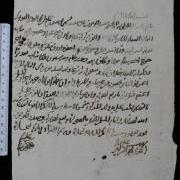The project examines both edited and uned ited Arabic legal documents from a new, comparative perspective. Documents, as immediate manifestations of legal practice, were instruments for guaranteeing subjective rights of persons for whom the copy had been issued. Most studies on Medieval Islamic legal practice, however, focus on literary sources (notarial manuals, responsae, juridical treaties) and neglect documents mainly for two reasons: 1) cursive handwriting and technical language make it difficult to decipher them; 2) the existing collections come from varied sources, which hindered their synthetic analysis. This project inverts the focus with a new historical perspective: thanks to its innovative full-text database that analyses documents based on functional components and sequence-patterns, it reveals significant variations in structure and juridical clauses among a relevant number of documents, both in detail and from multiple aspects.
ited Arabic legal documents from a new, comparative perspective. Documents, as immediate manifestations of legal practice, were instruments for guaranteeing subjective rights of persons for whom the copy had been issued. Most studies on Medieval Islamic legal practice, however, focus on literary sources (notarial manuals, responsae, juridical treaties) and neglect documents mainly for two reasons: 1) cursive handwriting and technical language make it difficult to decipher them; 2) the existing collections come from varied sources, which hindered their synthetic analysis. This project inverts the focus with a new historical perspective: thanks to its innovative full-text database that analyses documents based on functional components and sequence-patterns, it reveals significant variations in structure and juridical clauses among a relevant number of documents, both in detail and from multiple aspects.
From the final phase of the ERC-financed phase of the project onwards, the ILM-project members have made an effort to render their work available to a wider community. Two different research tools are proposed for researchers studying Islamic documentary texts:
1) The “Corpus of Arabic Legal Documents”: see http://cald.irht.cnrs.fr
2) A new version of the database aiming to enlarge the former ILM-research group.